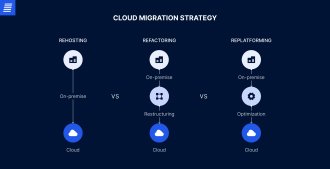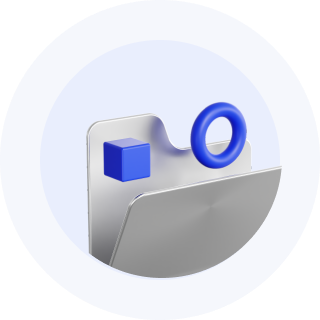
Contact us
Our team would love to hear from you.

In 2025, 84% of business leaders named cost management as a top cloud challenge. Overall cloud expenditures are expected to increase by 28% over the next year, while organizations are already overspending their budgets by 17% on average. This has prompted companies with either private, public, or hybrid cloud infrastructure to explore alternatives. One compelling option is Oracle Cloud Infrastructure (OCI). This platform offers strong performance and enterprise-grade security, leading a growing number of organizations to choose OCI as their cloud infrastructure provider. Thus, in fiscal 2024, OCI (IaaS) revenue grew 42% year-over-year to $2.0 billion in the fourth quarter.
Read on to discover the factors influencing cloud migration cost, how OCI facilitates smart, cost-efficient cloud transitions, and key pitfalls to avoid to ensure long-term benefits.
Migration can reduce expenses, but only with careful planning and a clear understanding of existing assets. This requires looking beyond price differences to consider operational shifts, hidden expenses, and how the change will impact teams. This comprehensive approach enables an accurate estimate of cloud migration cost. Key factors are outlined below.
Up to 27% of cloud spending is typically wasted due to overprovisioning and idle resources. Selecting the appropriate OCI virtual machine (VM) is just the first step. To keep costs under control, it’s equally important to manage resource consumption over time. This involves using features like auto-scaling, flexible VM shapes, and scheduled outages. OCI tools like Cloud Advisor, Cost Analysis, and Metrics Explorer are designed to facilitate this process.
Moving data into OCI is free, as is the first 10 TB of outbound traffic per month, regardless of region. However, once the threshold is exceeded, outbound data incurs additional costs that vary based on location, from $0.0085/GB in North America, the UK, and Europe to $0.05/GB in the Middle East and Africa.
Licensing directly influences both short-term migration costs and long-term cloud maintenance expenditures. For businesses already invested in Oracle technologies, OCI offers the Bring Your Own License (BYOL) program, which allows businesses to apply their current licenses to equivalent services running on OCI. Meanwhile, software from other vendors may come with cloud-specific restrictions, penalties, or requirements for new agreements. That’s why it’s critical to review the portability terms of the license beforehand to accurately estimate the profitability of the OCI migration.
The overall expense of OCI migration depends on the strategy you choose, which can open the door to major savings or create future losses. After all, even the lowest upfront cost doesn’t always mean the best long-term value.
The least expensive strategy is rehosting (also called lift-and-shift), which involves moving the current systems to OCI without major changes. While this option is fast and cheap, it sometimes carries inefficiencies from the old environment.
Refactoring (or rearchitecting) takes the opposite approach by completely redesigning apps. It unlocks long-term cloud benefits like elasticity and scalability but comes with high upfront costs and longer timelines.
Replatforming (also called lift, tinker, and shift) is a middle ground between rehosting and refactoring. With this approach, the app isn’t completely rebuilt, but some adjustments and improvements are made before the move to the cloud.
Sometimes, the most cost-efficient and optimal move is replacing a legacy app with a Software-as-a-Service (SaaS) solution. This strategy is called repurchasing (or drop and shop).


Migrating from on-premises to the cloud requires a network and security redesign, especially in hybrid cloud environments. This includes setting up dedicated connections, such as OCI FastConnect, updating security protocols, and reconfiguring VPNs for seamless integration with hybrid cloud. These changes involve additional costs for new hardware, licensing for advanced networking and security solutions, and expert services.
Some factors don’t appear in high-level estimates or cloud migration cost calculators, yet they quietly drive up expenditures.
Even with a well-thought-out strategy, some interruptions are inevitable for data transfers, system switchover, or testing delays. Without adequate preparation, this can result in lost productivity, missed transactions, and customer dissatisfaction, all of which increase costs.
In hybrid setups, compatibility between the new cloud environment and existing on-premises systems is key to smooth operations. These integration efforts should also be anticipated and included in the overall cost planning.
This factor is particularly sensitive for businesses moving to OCI from on-premises. Migrating to the cloud changes how teams work, processes function, and support is provided. Therefore, it’s essential to include workshops and OCI certifications to upskill employees, empowering them to efficiently manage cloud solutions.
During Oracle cloud migration, there may be a period when both on-premises and cloud versions of the same app are running simultaneously. This overlap usually occurs while the new environment is being tested. In some scenarios, the on-premises system is maintained for a short time after cutover in case a rollback is needed.
OCI helps organizations get the most value from their infrastructure by offering the following benefits of moving to the cloud.
In addition to the previously mentioned 10 TB of free outbound data per month, OCI offers over 20 Always Free services with no expiration, including two Autonomous Databases, AMD and Arm Compute VMs, as well as storage. In addition, new users get $300 in free credits to try other cloud services.
OCI offers lower prices on a range of services compared to its major competitors. Additionally, OCI customers get the same services, performance, and prices no matter where they are.
With OCI, companies can select the number of cores and memory based on their workloads, whether they are using AMD, Ampere, or Intel processors. This eliminates overprovisioning and reduces spending on unused resources.
OCI includes enterprise-grade technical support for mission-critical workloads—no separate support plan or extra fees required.
The more you use OCI, the more you save. With Oracle Support Rewards, each $1 spent on OCI earns up to $0.33 in credits that can be used to pay on-premises software support bills, even covering them in full.
OCI provides free guidance from their cloud engineers to help with migration planning, architecting, prototyping, and execution.
Beyond expert support, OCI also offers a set of tools that facilitate, automate, and accelerate cloud migration. Key tools are described below.
This online OCI cost calculator is an invaluable tool for accurate budget planning and data-driven decision-making. It allows businesses to forecast cloud migration costs for compute, storage, data transfer, and other services.
ZDM is a fully automated tool for migrating Oracle databases to OCI with minimal or no downtime. With Oracle Maximum Availability Architecture technologies, this solution ensures data integrity and continuity, which is ideal for mission-critical systems that can’t afford interruptions.
OCI Database Migration is a fully managed service that provides cross-version, fault-tolerant Oracle database and MySQL migrations for both online and offline use cases. Designed with usability in mind, it offers a unified, intuitive experience accessible to users of all backgrounds. What’s more, the OCI Database Migration service is available for free for up to six months.

This unified platform allows users to perform physical migration while apps are online or offline. Built-in tools like Migration Workbench and Performance Hub provide deep visibility into workloads, dependencies, and performance metrics, ensuring that critical systems are optimized from day one.
This is a robust built-in database utility for backing up, restoring, and recovering Oracle Databases. Recovery Manager works directly with the database engine to detect block-level corruption, optimize storage with backup multiplexing and compression, and seamlessly integrate with Oracle Secure Backup and third-party media solutions for tape-based recovery.
Global leading companies choose OCI for its numerous advantages, including reliability, performance, predictable pricing, and cloud security.
When Zoom’s daily tally of users surged from 10 to 300 million, the company needed a robust platform that could handle massive scale without compromising performance. Once deployed, OCI instantly supported hundreds of thousands of concurrent Zoom meetings. Within weeks, that number grew to millions, and Zoom was able to scale seamlessly to accommodate that need through OCI Functions. Today, Zoom transfers over 7 petabytes of data daily through OCI, which is enough to stream HD video nonstop for over 90 years.
To improve car design and development efficiency, Toyota moved its high-performance computing workloads from on-premises systems to OCI. This helped the company significantly reduce lead times in computing resource procurement, from more than six months in the on-premises environment to just a few days in the cloud, improving cost performance and accelerating the testing of new technologies.
Seeking to minimize the company’s data center footprint and modernize finance systems, FedEx migrated its accounts—processing over 15.5 million packages daily and 500+ TB of data—to OCI. This decision allowed the organization to significantly speed up invoice and payment processing, lower computing costs, and run daily collections globally. During peak seasons, FedEx can now instantly scale compute resources without system outages. Accounting teams now close month-end and quarter-end processes several days faster. This migration freed IT engineers from performing hardware support, allowing them to focus on initiatives like developing new customer-facing features.
Understanding cost drivers, uncovering hidden inefficiencies, and adopting a strategic approach lead to significant savings in cloud migration. The most important decision is choosing the right cloud provider. OCI is the ideal solution. It offers all the benefits of moving to the cloud, including competitive prices, high performance, built-in security, and advanced tools and support. At EffectiveSoft, we provide comprehensive OCI development services. If you are seeking expert help, our Oracle-certified engineers will support you through every step of your cloud migration.

The cost varies based on the workload, migration strategy, licensing terms, and more. To estimate expenses, use this OCI cost calculator or contact our experts directly.
OCI offers lower rates for certain services and workloads compared to its major cloud competitors like AWS, Azure, and GCP. Furthermore, OCI pricing is consistent, which helps medium-sized businesses more effectively plan their cloud budgets.
Clearly assess your current resource usage to avoid overprovisioning, properly allocate your computing services, use advanced tools, and enlist certified experts.
We have a strong team of certified engineers with hands-on experience in cloud projects across industries. We use modern cloud-native tools, follow DevOps and FinOps best practices, and design scalable, fault-tolerant systems. In addition, our managers provide detailed estimates and keep them up to date during the entire project lifecycle.
First, OCI supports enterprise-grade security by default. This involves encrypted data transfer, strict access control, and compliance with major industry frameworks. Second, our team pays particular attention to the safety of your systems, data, and configurations by regularly reviewing access policies, validating configurations, conducting comprehensive testing, and monitoring the environment during cutover.
Can’t find the answer you are looking for?
Contact us and we will get in touch with you shortly.
Our team would love to hear from you.
Fill out the form, and we’ve got you covered.
What happens next?
San Diego, California
4445 Eastgate Mall, Suite 200
92121, 1-800-288-9659
San Francisco, California
50 California St #1500
94111, 1-800-288-9659
Pittsburgh, Pennsylvania
One Oxford Centre, 500 Grant St Suite 2900
15219, 1-800-288-9659
Durham, North Carolina
RTP Meridian, 2530 Meridian Pkwy Suite 300
27713, 1-800-288-9659
San Jose, Costa Rica
Escazú Corporate Centre, Piso 6
40602, 1-800-288-9659